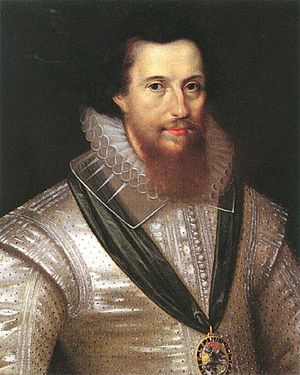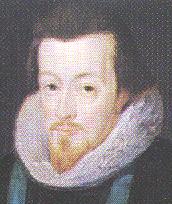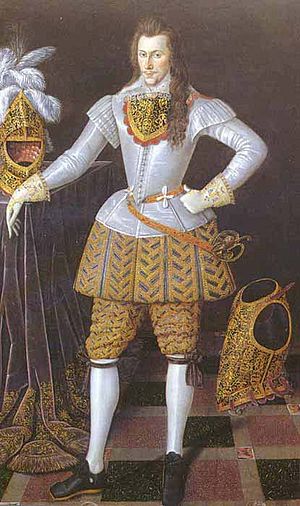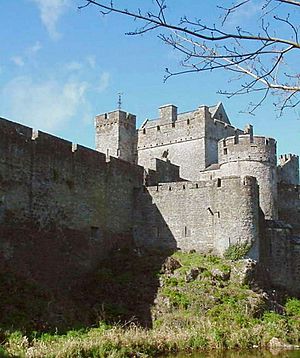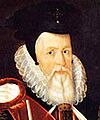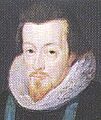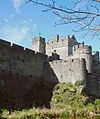Essex in Ireland facts for kids
Essex in Ireland is about a military trip to Ireland in 1599. It was led by Robert Devereux, 2nd Earl of Essex, during a big conflict called the Nine Years War.
In 1598, Queen Elizabeth I of England needed to pick a military leader for Ireland. Her court had two main groups: one led by Essex, and another by her secretary, Sir Robert Cecil. Essex offered to lead the army, and the Queen agreed. However, his campaign did not go well. Essex returned to England and later challenged the Queen's power. He was found guilty and lost his life in 1601.
Contents
Essex Becomes Commander
In the 1590s, Essex was very popular in London. People saw him as a strong supporter of the Protestant faith. During the war with Spain (1585–1604), he wanted to fight aggressively. He supported Dutch rebels and French Huguenots against their Catholic enemies. He also pushed for attacks on Spain and a direct war against the Irish leader O'Neill.
The Queen's main secretary, Lord Burghley, disagreed with Essex's aggressive plans. He preferred peace and a calm approach in Ireland. In April 1598, Burghley and Essex had a big argument. Essex said peace was dishonorable, but Burghley believed Essex only wanted "war, slaughter and blood."
Later that summer, the Queen and her advisors argued about who should lead the army in Ireland. Essex turned his back on the Queen, which made her very angry. She hit him on the head. Essex reached for his sword, but someone stopped him. He then left the room, saying he would not accept such an insult.
After this, Essex lost much of his influence at court. But the Queen soon faced more problems. In August, Lord Burghley died. Ten days later, her army in Ireland suffered a big loss at the Battle of the Yellow Ford. A few weeks after that, King Phillip II of Spain also died.
The two groups at court continued to fight for power. Essex and Cecil tried to get rid of each other's supporters by suggesting them for the Irish command. Eventually, the Cecil group suggested Essex himself as the only choice left. Essex felt he had to accept. On December 30, the Queen officially chose him as Lord Lieutenant of Ireland. Essex announced he would defeat O'Neill in battle.
Essex's Powers and Army
Essex danced with the Queen at a party in January 1599. The Queen had some doubts about the campaign, but plans were ready by March. Essex was given special powers. He could pardon O'Neill if he surrendered. He could also give knighthoods to deserving soldiers.
The army was huge, with 16,000 foot soldiers and 1,300 horsemen. Among them were 2,000 experienced soldiers from a campaign in the Netherlands. The plan was to send 2,000 new soldiers from England every three months. A regular postal service was set up between Dublin and London. Essex also commanded five warships and other boats. These ships were meant to land in the north at Lough Foyle. However, the ships stayed in southern waters and did not help in the northern campaign.
This army was the largest ever sent to Ireland. It had all the supplies needed, like weapons, clothes, and food. The campaign was expected to cost a lot of money, about £290,000 each year. This was twice the cost of Elizabeth's campaign in the Netherlands. The Irish rebels received supplies from Spain and Scotland. They had about 20,000 to 30,000 troops. Many of them were in Ulster, where the Queen's power was weak.
Departure from England
Essex left London on March 27, 1599. People prayed for his success. Crowds cheered him on for four miles. Noblemen like Blount and Southampton went with him. Essex appointed them even though the Queen did not want him to.
On April 5, Essex waited at Hilbre for good winds. A week later, he sailed from Beaumaris. He had a rough journey and reached Dublin on April 15. He was sworn into office that same day.
The campaign had already faced problems. In January, Sir Richard Bingham, an experienced commander, died in Dublin. He was supposed to lead 5,000 soldiers. After Essex arrived, the young Earl of Kildare also died. His ship sank in the Irish Sea, and he drowned with eighteen Irish noblemen.
In his first week, Essex held a grand event in Dublin. It was a show of English chivalry. The Queen in London had a simpler ceremony because of the war. When she heard about Essex's lavish event, she gave a valuable position to Cecil instead of Essex. Essex faced more embarrassment when he inspected soldiers in Drogheda. He charged at them on his horse as a joke, but they stood firm. He had to pull back his horse and was pricked by a pike.
Planning the Campaign
The original plan was to attack by land and sea at the same time. But this was probably too difficult for England. There were rumors of a new Spanish fleet, and warships were needed in southern waters. The plan to set up a base at Lough Foyle in the north was dropped. The Dublin Council then decided against an immediate attack on O'Neill. They realized they would not have enough food or horses. However, the Queen's council in London still wanted a direct attack north into Ulster.
The Dublin Council might have been right. O'Neill removed food and horses from areas near The Pale (an area around Dublin loyal to the Queen). He also encouraged a rebellion in Munster by the White Knight. Meanwhile, O'Donnell moved into Connacht. It seemed war was preparing everywhere.
The Dublin Council advised Essex to attack O'Neill's allies in the east, near the Pale. Essex seemed to follow this advice. He sent 5,000 soldiers to garrisons along the Pale's border. To fight the White Knight, he sent more troops to Cork on the south coast. More soldiers were sent to Munster and Kilkenny. In the west, the army of Sir Conyers Clifford was increased to 3,000. Essex decided to postpone the northern threat. Instead, he chose to go south and try to control Ireland by touring through Munster and then back to Dublin.
Southern Campaign
Essex left Dublin on May 9. He gathered his army at the Curragh in Kildare. He marched south, taking Athy castle. The O'Mores bothered him as he went past the Pale. He helped the fort of Maryborough. The first big fight happened in May at the pass of Cashel in Queens County. This pass was wooded and boggy. Essex's soldiers fought bravely and pushed through. The English lost some officers and men. The Irish claimed to have killed 500. The rebels captured many feathered helmets, so the battle became known as The Pass of the Plumes.
On May 18, Essex marched south to Kilkenny with most of his army. The city welcomed him. After meeting with Thomas Norris, Essex left on May 22. He was cheered in Clonmel. He took Derrylare castle, and then aimed for Cahir Castle, the strongest fortress in Ireland.
Essex believed Lord Cahir was helping the White Knight. After talks to surrender the castle failed, the English attacked. They fired cannons for two days, breaking the wall. The castle defenders ran away. Essex entered Cahir Castle on May 29.
Essex marched west to Limerick city, arriving on June 4. Here, a large group of baggage porters joined the army. They were twice as many as the fighting men and used up many resources. At Askeaton, the army got new supplies. They had met the Sugán Earl, a fake Earl of Desmond, who had 2,000-3,000 men.
Essex realized the Munster rebels would not let themselves be trapped. He decided to march south to try and make them fight. At Kilmallock, he talked with President Thomas Norris. Conditions were getting worse. Soldiers were not enthusiastic. There was no money, no supplies, and hardly any food or ammunition. The army marched further south while Essex went to Mallow to get supplies. He rejoined his men with a MacCarthy ally. But by the time he reached the heart of Desmond country, the Sugán Earl and other rebels had moved away.
Essex crossed the Blackwater river at Affane. He held a meeting and allowed Norris 1,100 foot soldiers and some horsemen to continue the war in Munster. Essex marched east to Waterford City. He was welcomed there on June 21. The army was ferried across the river, which took a long time. Essex left Waterford on June 22.
Return to Dublin
The way back to Dublin was north through Wicklow. The English commander Henry Harrington had been badly defeated there on May 29 by the rebel Phelim MacFeagh O'Byrne. Essex marched over the Slaney river with 1,200 fighting men. He chose to go by the coast to avoid the hills. Along the way, his men burned villages. O'Byrne confronted them with 1,000 troops near Arklow. The Earl of Southampton crossed a deep river with the horsemen. The Earl of Ormond led the army over a ford. The rebels fought hard and defeated the English, killing many. Essex marched on to Dublin, arriving on July 2.
After eight weeks, Essex had only about 300 horsemen left. Not one rebel leader had surrendered. No area was fully under control. Many soldiers were spread out in garrisons or lost to disease and desertion. In London, Essex was criticized for fixing coastal defenses in Ireland. This was happening when England was worried about a Spanish attack.
Essex planned a second attack, even though the Queen did not approve. Maryborough and Philipstown were resupplied around July 25. Essex fought rebel Captain Tyrrell. Harrington and Clifford also took part, but lost many men. A surprise attack on the O'Connors was successful. Their children were exposed, their corn was burned, and 500 cows were taken. But Essex still failed to fight a major rebel force and returned to Dublin.
Clifford went back to Connacht. He was killed, and his forces were defeated at the Battle of Curlew Pass. This defeat, so soon after Harrington's loss, was seen as a huge blow to the English in Ireland. The Queen's court blamed Essex. O'Neill was now safe in the west, and an attack on his land in Ulster seemed unlikely. The Queen's power in Ireland was in danger.
Northern Campaign and Truce
During the campaign, Essex had given out too many knighthoods. The Queen was angry, saying he would make the honor meaningless. She was very frustrated with the news from Ireland. On July 30, 1599, she ordered an immediate attack on O'Neill.
Essex agreed, but he was not feeling well. Others also doubted the Queen's plan. The rebels were strong in the west, making an attack from the south very risky without a base in Lough Foyle. A council of war voted against the plan. A month later, the Queen angrily criticized Essex. She complained that only 5,000 soldiers were available, not twice that number. Reinforcing the Irish army was hard because of rumors of a Spanish landing in England. Essex also suspected some of the Queen's advisors were working against him. But seven days after the council meeting, Essex set out for the north. He hoped to end the war quickly.
Essex left Dublin on August 28. His army gathered near Kells three days later. It had 3,700 foot soldiers and 300 horsemen. O'Neill's readiness to attack the Pale stopped Essex from going further. Essex wrote to the Queen, saying Kells should be the winter border garrison. On September 2, he marched to Ardee. O'Neill's army was seen across a river. The English claimed O'Neill had many soldiers. Essex decided not to fight because his forces were smaller. He set up camp. O'Neill moved along the side, staying in the woods.
The two commanders talked. On September 6, Essex advanced with 2,000 foot soldiers and 300 horsemen. He arranged his army in a cross shape. His war council hoped for an Irish attack. The next day, O'Neill's messenger told Essex that O'Neill wanted the Queen's mercy. He suggested a meeting at the ford of Bellaclinthe.
On September 7, Essex rejected the meeting place. But O'Neill rode into the river, showing humility. Essex rode to a nearby hill, then went down alone to the ford. He talked with O'Neill for half an hour. Both men then returned to their groups. A formal meeting followed with six witnesses on each side. Essex stayed on the bank, while the Irish rode into the river. O'Neill spoke respectfully. After half an hour, another meeting was planned for the next morning.
Essex continued his march to Drumcondra. O'Neill returned to his camp. At the meeting on September 8, O'Neill was there, but Essex was not. They agreed to a truce for six weeks, lasting until May Day. Either side could break it with fourteen days' warning. The English could attack O'Neill's allies if they did not agree to the truce. The terms also said that all stolen goods should be returned. The rebels would keep the lands they had. No new garrisons would be placed. Safe travel would be allowed. All English garrisons would be told about the truce. Commissioners would be appointed for the borders. O'Neill would swear an oath, and Essex would give his word. The terms were written down and signed by O'Neill. The next day, Essex sent his army away and went to Drogheda. O'Neill returned to his lands.
Essex's Return to England
In mid-September 1599, the Queen wrote to Essex with more criticisms. She told him not to leave Ireland without her special permission. A week later, he gave control of his government to two lords. He put Ormond in charge of the army. He also said the truce should continue. On September 24, Essex boldly sailed for England. He relied on a general permission he had to return. He reached London on September 28. He surprised the Queen in her room before she was fully dressed.
Elizabeth said the truce was a "quick end made of a slow proceeding." People generally thought Essex's time in Ireland had not been useful. Essex only told the Queen what he and O'Neill had discussed. He had promised to deliver O'Neill's request verbally. At first, the Queen did not suspect disloyalty. But she spoke strongly about O'Neill, saying he could not be trusted. She ordered no agreement or pardon without her approval. However, she later admitted the truce was helpful. Meanwhile, Essex was held in custody. On November 29, the council criticized him.
O'Neill was unsure about the truce. His ally, O'Donnell, argued that too much had been given to the English. O'Neill then made a list of demands. These included religious freedom, less English influence, and keeping lands the rebels controlled. These were likely the main points from his private talk with Essex. In a report from November 18, rebels were said to have made fun of Essex. They said he only drew his sword to make knights, and that he left before finishing his job. Later that month, another meeting happened, and the truce was extended for one month. In December, O'Neill complained that the truce was being broken. In the spring of 1600, he started a campaign through Munster.
Essex's Downfall
The details of Essex's private talk with O'Neill became a big topic in England. Rumors spread that Essex was disloyal. As he lost favor at court, Essex decided to challenge the Queen's authority. He left his house arrest and rode through London with his supporters to try and see the Queen. But he was stopped by a good defense. Cecil insisted that Essex was acting against the Queen. After a quick trial, Essex was found guilty and lost his life in February 1601.
Years later, some information from Spain suggested that Essex had talked with O'Neill about starting a rebellion against the Queen. This was supposedly why Essex lost his life. It was also said that O'Neill almost convinced Essex to leave Queen Elizabeth's service and join King Philip III of Spain. O'Neill supposedly promised Essex great favor from the Spanish king.
Essex knew he was taking a risk by leaving the court in 1599. He left the way open for Cecil. His risk would only pay off if he defeated O'Neill. But the Irish campaign was much harder than he expected. Essex was the last English commander of that time to underestimate the rebels. The situation at court quickly got worse, and Cecil gained a lot of influence over the Queen. Essex's private talk with O'Neill was very important. At that time, Cecil was planning for King James VI of Scotland to become the next ruler after Elizabeth. Essex's unauthorized return from Ireland was a desperate attempt to stop these plans. When that failed, his later actions were because he refused to accept that Cecil, not he, would decide who would be the next ruler.
Images for kids


